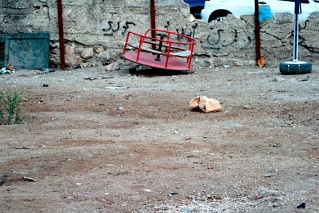 Illustration. Photo by Mirah Curzer
Illustration. Photo by Mirah CurzerEast Jerusalem in Numbers
May 2012
Population:
360,882 Palestinians comprising 38% of Jerusalem’s total population.
Revocation of Residency: Since 1967, the residency status of 14,084 Palestinians has been revoked and rescinded, and these former residents are no longer permitted to live in their city.
Poverty Rate: 78% of Palestinians living in the Jerusalem district and 84% of the children live below the poverty line – the worst rate of all time.
Welfare Offices: 3 offices in East Jerusalem handle roughly one third of Jerusalem’s population, while 18 such offices operate in West Jerusalem; even with the addition of 19 welfare officer positions in East Jerusalem, there is still a tremendous work backlog and the need for 15 additional full-time positions.
Children at Risk: East Jerusalem is home to 6150 at-risk children; the rate of family violence is rising. 71 East Jerusalem children were sent to institutions in the north of the country in 2010, owing to a lack of suitable frameworks in Jerusalem for Arab children.
Shortage of Classrooms: There is a chronic shortage of some 1000 classrooms in East Jerusalem’s educational system; despite the commitments made by Israeli authorities to the courts, the new classrooms that have been built have not succeeded in closing that gap.
Shortage of Pre-Kindergartens: There are 6 municipal pre-kindergartens in East Jerusalem as compared to 66 in West Jerusalem; this fact will make it incredibly difficult to implement the government decision that the Mandatory Free Education Law should apply to children aged 3-4 during the upcoming school year.
Secondary School and University Education: The drop-out rate for 12th graders in East Jerusalem is 40%; students with a Tawjihi diploma (Palestinian/Jordanian high-school matriculation) find it hard to gain acceptance into Israeli universities; some of the degrees offered by Palestinian universities, including Al-Quds University, are not recognized in Israel.
Professions and Industry: 25% of Palestinians living in Jerusalem and its immediate surroundings are employed in the hotel and restaurant sector; 19% are in education; 19% are public service providers; the sole Palestinian industrial park in Jerusalem’s Wadi Joz neighborhood is in danger of closing.
Planning and Building: Palestinians are permitted to build on only 17% of the area of East Jerusalem, most of which has already been totally exhausted by previous construction; Nearly all Palestinian neighborhoods are lacking detailed outline plans; the building ratio allowed in Palestinian neighborhoods is generally between 35%-75%, while in Jewish neighborhoods it stands between 75%-150%.
Land Expropriation: A third of Palestinian land in Jerusalem has been expropriated since 1967, upon which thousands of apartments have been built for the city’s Jewish population; 35% of the planned areas in Palestinian neighborhoods have been designated as “open landscape areas” on which it is forbidden to build.
Housing and Crowding: Between 2005-2009, only 13% of the Jerusalem housing units granted building permits were in Palestinian neighborhoods; in Jewish neighborhoods, there is an average of 20 square meters of housing per resident, compared to 11 square meters in Palestinian neighborhoods.
Separation Barrier and Checkpoints: The building of 142 km. of the Separation Barrier, the closing of passage points, and the implementation of an “entry permit regime” have effectively cut off East Jerusalem from the West Bank, exacerbating the economic and social condition of its residents.
Neighborhoods Beyond the Separation Barrier: Some 90,000 East Jerusalem residents with blue Israeli identity cards living in the neighborhoods of Ras Hamis, Dahiyat al-Salaam, the Shuafat Refugee Camp, Kafr Aqab, and Samiramis are cut off from the bulk of the city, and need to pass through checkpoints on a daily basis in order to get to work, attend school, obtain medical services, visit family, etc.
East Jerusalem Hospitals: The building of the Separation Barrier and the restrictions on entry from the West Bank, imposed both on patients and medical staff, have led to a severe financial crisis in East Jerusalem’s hospitals, which provide the bulk of medical services for the entire West Bank. In 2006, the rate of Jerusalem residents living beyond the Separation Barrier who sought medical attention at these hospitals dropped precipitously from 69% to 29%.
Sewage: There is a shortage of some 50 km. of sewage pipes, and residents instead use septic tanks; repeated flooding of these systems causes serious health hazards; there are ongoing difficulties in connecting residents to the urban water system.
Postal Services: There are only 9 Post Offices in East Jerusalem compared with 42 in West Jerusalem; delivery of mail is infrequent and irregular.








Pingback: PALESTINE NEWS | May 20, 2012 | Occupied Palestine | فلسطين
Pingback: Peace Not Walls » Blog Archive » Jerusalem – Separate and unequal - Evangelical Lutheran Church in America
Pingback: PALESTINE NEWS | May 20, 2012
Pingback: Jerusalem Day 2012: Unprecedented Deterioration in East Jerusalem | [···]